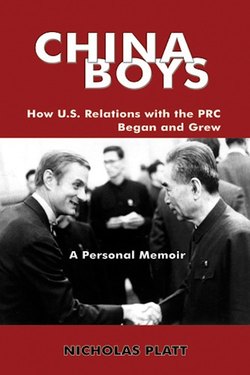Читать книгу CHINA BOYS: How U.S. Relations With the PRC Began and Grew. A Personal Memoir - Nicholas MD Platt - Страница 16
На сайте Литреса книга снята с продажи.
Taiwan at Last
ОглавлениеThe prospect of living and communicating in a real Chinese place had buoyed us through the long months of drudgery in Arlington Towers. We were itching for the final phase of our formal training, a year at the FSI Field School in Taiwan. Our teachers thought we were ready, too. After eleven months training in Washington, my classmates and I qualified at level 2 (out of 5). This meant that we could operate safely in a Chinese environment, but were not yet able to work professionally (level 3). We infants had become teenagers.
Sheila was eager, too, having studied the spoken language at her expense with FSI teachers in the evenings during our months in Washington. The State Department provided no money to train wives.
We had never been to Asia. The long flight to Taiwan via Hawaii and Japan with two small sons, Adam and Oliver, was a major passage for our family. We fought jet lag and culture shock in Tokyo, our sense of strangeness compounded by staying at the Imperial Hotel designed by Frank Lloyd Wright. This massive pile of scratchy yellow masonry, earthquake-proof by virtue of its thickness, made its inhabitants feel like ants in a hill. After two days of peering sleepily through misty pollution at the famous sights of Japan’s capital, we took off for Taiwan. Arriving at the airport in Taipei, we found instant comfort because we could actually communicate. The long hours of training began to pay off.
In 1963, the Republic of China on Taiwan, like the People’s Republic of China across the Straits, was a single-party police state under an authoritarian ruler. But in contrast to the economic stagnation and starvation on the Mainland, rapid growth in agriculture under a land reform program designed by American and Chinese economists and enforced by the strict government was beginning to spur the entire economy. Nationalist Mainlanders under Generalissimo Chiang Kai-shek and his wife, the fearsome, accomplished Wellesley graduate Soong Mei-ling, dominated politics, the army, and the police. Native Taiwanese, who had received higher education as doctors and agriculturalists under Japanese rule (1895–1945), were taking charge of the economy and the underground political opposition.
The FSI Field School was located in the city of Taichung, nearly ninety miles down the coast, happily removed from the distractions of embassy life, the demands of the ambassador, and the grim, drizzly weather of the capital.
Today Taiwan’s largest city, with a population of several million and a bustling port on the Taiwan straits, Taichung was then a much smaller, slower place, where 600,000 people dwelled. The city limits ended long before one reached the sea. Electricity was limited and nights were dark. Motorbikes and cars had yet to replace bullock carts and pedicabs, though the process had begun. Water buffaloes plowed the green rice paddies under sunny skies, framed by wrinkled, blue mountains in the background. We rented a Japanese-style house in a walled compound at the end of a dirt road, a short bike ride from the school, and settled in happily.
“It is a shock to find oneself a curio,” I wrote my parents. “Yesterday I was downtown engrossed in bargaining for a balloon for the boys. Nearing the end of this exhilarating process, I looked up and found myself surrounded by a crowd of at least fifty people. Sheila, on the other hand isn’t just a curio, she’s a phenomenon!
Walking in the park the other day, clad in her rather full blue overcoat (the one that makes her look like a six-foot tea cozy), the Chinese crowded around exclaiming “Tai da” (“too big”). The reaction, far from being mirthful, was one of awe and amazement. It was Queen Liliakulani walking in their midst.” (She was also carrying our third son.)1
Sheila wrote:
The boys are really thriving, and they’ve made a clutch of Chinese friends in the neighborhood. Yesterday Adam sailed forth bright and early, dressed in blue overalls, a red shirt, cowboy hat jammed down over his nose, red bandanna around his neck, and a flashy Hong Kong cap pistol and holster low on the hips. He was met by a horde of admirers outside the gate, and they escorted him to their stomping ground under a bush, where they placed him on a bamboo stool, seated themselves on stones in a circle around him and proceeded to admire him. Adam thought this was great, especially when they gave him some caps for his pistol, and he had a fine noisy time for the rest of the morning. . . . Adam and Oliver are known as “Big Tiger ” and “Tiger Number Two.”2
Every school-day morning, pressed handkerchiefs pinned to their clean shirts, the boys were carted off to a missionary kindergarten in a yellow pedicab bus filled with neighborhood Chinese.
